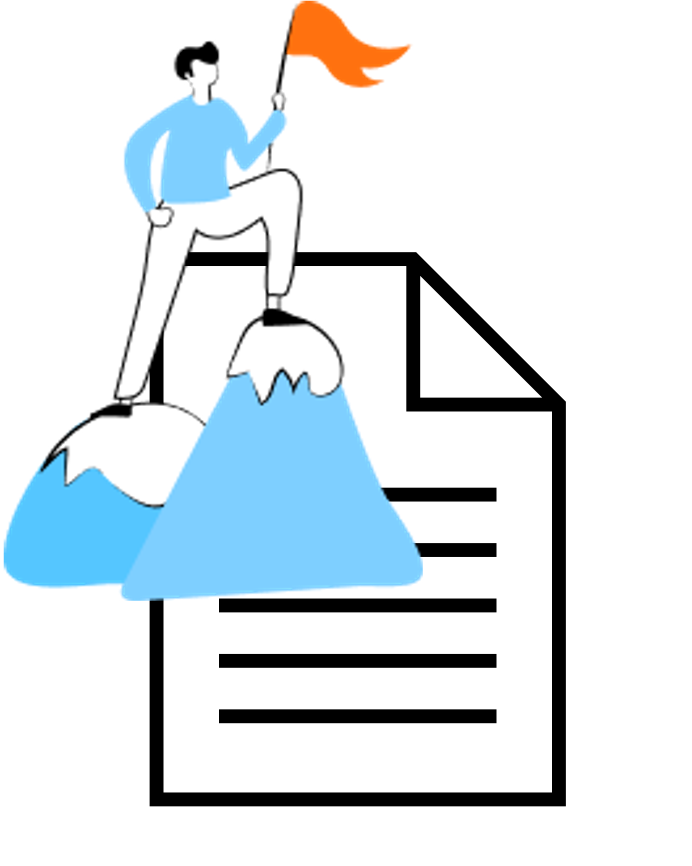Management by Objectives (MBO) is a process whereby organisations set specific goals to give direction and structure to their activities. By defining and clearly communicating objectives at different levels, organisations can better focus their resources and efforts to achieve desired results. MBO is about creating clear, measurable and realistic objectives that are aligned with the organisation's overall vision and strategy.
The history of goal management
Management by objectives has its roots in the 1950s and was introduced by Peter Drucker, a pioneer in management theory. Drucker believed that organizations would function more effectively if they had clear and measurable goals to which all employees aspired. Over the years, goal management has been developed and adapted to different industries and businesses, but the basic principle of setting and following up on goals has remained central.

Decisive advantages of goal management
-
Clear direction and focus: By setting specific goals, organizations can ensure that all employees are working towards the same overall vision.
-
Motivation and commitment: When employees understand what is expected of them and see how their work contributes to larger goals, their motivation and commitment increase.
-
Efficient use of resources: Management by objectives helps organizations focus their resources on the areas most critical to success.
-
Measurable results: By setting measurable goals, organizations can easily track and evaluate progress toward those goals, facilitating adjustments and improvements as needed

What goal management can be used for
-
Financial goals: Set and achieve goals to increase turnover or improve profitability.
-
Personnel development: Identify and develop employee competencies and career paths.
-
Customer service: Increase customer satisfaction by setting clear targets for response times and resolution rate.
-
Project management: Ensure that projects are delivered on time and within budget.
-
Innovation: Drive research and development by setting goals for new ideas and solutions.
-
Market shares: Increase market share by focusing on new customer segments and geographic areas.
-
Efficiency: Create a clear direction, focus efforts and measure progress towards goals.
Management by objectives helps organizations improve efficiency and achieve success in a variety of areas.

Challenges and disadvantages of management by objectives
-
Stiffness: Management by objectives can sometimes lead to organizations becoming too rigid and not flexible enough to quickly adapt to changes.
-
Excessive focus on quantitative goals: This can lead to qualitative aspects of the work being overlooked.
-
Short term: Focus on short-term goals can sometimes obscure the long-term strategic visions.
-
Motivation: If the goals are unrealistic or too difficult to achieve, it can lead to reduced motivation among employees.

To implement target management in the business
To effectively implement goal management in a business, the following steps can be helpful:
-
Define vision and business concept: Start by clearly defining the organization's overall vision and business concept.
-
Set strategic goals: Identify the long-term goals to be achieved to support the vision.
-
Break goals down into smaller sub-goals: Break down the strategic goals into smaller, manageable sub-goals that can be distributed across different departments and teams.
-
Communicate goals clearly: Ensure all employees understand the goals and their role in achieving them.
-
Follow up and evaluate: Use tools and methods to regularly follow up and evaluate progress towards goals. Adjust strategies and efforts as needed to keep the organization on track.
By following these steps, organizations can benefit from the structured and clear guidelines that management by objectives provides, which in turn can lead to improved efficiency and success.
Concrete examples of target management in practice
To really understand how goal management works in practice, it is helpful to look at concrete examples from different organizations. An example is a medium-sized IT company that implemented goal management to improve customer satisfaction. By setting clear targets for response times and resolution rates, the company was able to significantly improve its customer service.
Another example is a manufacturing industry that used target management to reduce production costs. By setting specific goals to reduce waste and optimize production processes, the company managed to reduce its costs by 15% in one year. These examples show how goal management can be used in different contexts to achieve measurable results.

OKR (Objectives and Key Results)
OKR, which stands for Objectives and Key Results, is a goal-setting methodology that has become increasingly popular among successful companies such as Google and Intel. It involves setting ambitious, inspiring goals (Objectives) and defining concrete, measurable key results (Key Results) that show progress towards those goals. For example, an objective might be to 'increase customer satisfaction', while Key Results might be to 'reduce customer support response time to under 24 hours' and 'raise customer satisfaction scores to 90%'. OKRs help organisations focus on what matters most, promote transparency by making goals and progress visible to everyone, and encourage regular monitoring and adjustment of strategies. By using OKRs, organisations can ensure that all employees are working towards the same overall goal and that their efforts are clearly linked to the company's success. This leads to increased motivation and commitment, and better coordination and efficiency within the organisation.

Tools and methods for goal management
To effectively implement goal management, it is important to use the right tools and methods. GoalEnvision is an example of a digital platform that supports the entire goal management process, from formulating vision and business idea to creating and following up strategic goals.
Tools that complement GoalEnvision include project management software such as Asana and Trello (connection to Trello is built into GoalEnvision), which make it easy to assign tasks to specific team members. Methods such as SMART goals (Specific, Measurable, Acceptable, Realistic, Time-bound) also help ensure that goals are clearly defined and achievable.
Success factors for effective goal management
In order for goal management to be effective, several important success factors are required. A strong and committed leadership is crucial to creating a culture where goal management is taken seriously and prioritized. Communication must be clear and consistent so that all employees understand the goals and their role in achieving them. Regular follow-up and evaluation is also necessary to be able to adjust strategies and measures when necessary. In addition, it is important to recognize and reward progress and achievements to keep motivation high within the team.
Future trends in goal management
Target management is constantly evolving and influenced by new trends and technologies. Digitization and artificial intelligence (AI) play an increasingly important role in how organizations set and follow up on their goals. The AI assistant in GoalEnvision can be used to analyze large amounts of data and provide insights on how goals can best be achieved. Flexible work models, such as remote work and the gig economy, also require new ways of setting and following up on goals. The goal management of the future is likely to be more adaptable and data-driven, with an increased focus on real-time monitoring and adjusting strategies based on current information.
How GoalEnvision helps you implement goal management
-
Define vision and business concept: GoalEnvision helps you create and communicate a clear vision and business idea that everyone in the organization can rally around.
-
Create growth and strategic goals: The platform makes it easy to set both overall growth goals and specific strategic goals, adapted to the organization's needs and ambitions.
-
Resource Allocation: GoalEnvision offers tools to allocate resources efficiently, ensuring the right people and tools are in place to achieve goals.
-
Follow-up and reporting: With functions for regular follow-up and reporting, you can continuously monitor the progress towards your goals and adjust strategies when necessary.
-
Communication tools: The platform includes tools to facilitate communication within the team, reducing the risk of misunderstandings and ensuring everyone is up to date.
-
Motivation and commitment: By clearly showing how each individual's work contributes to the overall goals, GoalEnvision can help increase the motivation and commitment of employees.
-
Analyzes and insights: GoalEnvision uses data and analytics to provide insights into which factors influence goal achievement, helping you make more informed decisions.
-
Customization and flexibility: The tool is flexible and can be adapted to different industries and organizational needs, making it possible to tailor the goal management process.
-
AI support: GoalEnvision offers AI-based recommendations to optimize the goal setting process and suggest improvements based on your data.
-
Survey library and feedback: The platform includes an extensive survey library that can be used to collect feedback and evaluate progress towards goals.
By using GoalEnvision, your organization can implement a structured and effective goal management process that supports long-term success.
Share this article
Did you like this article? Here is more...
Latest




